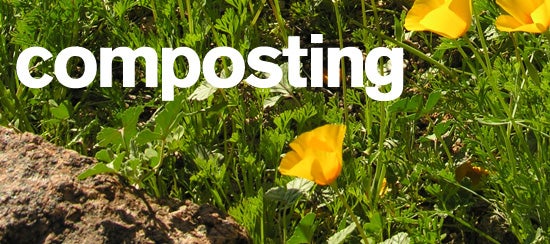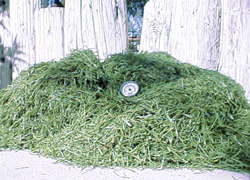
Decomposition in Action

Get yourself a large pile of grass clippings (best results are a foot or more wide and a foot deep) and a thermometer (the kind with a probe at the end of a wire is the best).
Testing Your Compost Pile
Start with fresh grass clippings and measure the temperature at the surface of the pile of grass and in the middle of the pile.
Repeat your temperature measurements every day for 7 to 10 days and also record the appearance of the grass clippings. You should be able to detect a temperature difference between the surface of your grass clippings and the center of the pile. The appearance of the clippings may start to change as they begin to decompose.
Temperature of Compost Piles

Which do you think will be hotter? How big do you think the difference will be?
Where is the heat coming from to make the difference?
Can you think of a way to test your answer?
After a week or ten days, what seems to be happening to the grass clippings?
What Do You Put in Your Compost Pile?
Afer you've learned a bit about the idea behind composting, you could try to build a pile that will stay at the appropriate temperatures needed for your waste to decompose correctly. This will make some great material for you to add to your garden (or to a friend's garden).
While grass clippings are a great addition to a compost pile, you will want other items in your compost as well. Make sure to add fruit and vegetable scraps in with your yard clippings. Eggshells and coffee grounds can also be mixed in, as can some of your paper scraps. Just make sure not to add any meat or other animal products aside from eggshells as these materials will attract bugs and other animals, and they require a bit more attention to decompose safely.
Images via Wikimedia Commons. Holding compost image by SuSanA Secretariat.
Read more about: Composting
Bibliographic details:
- Article: Composting
- Author(s): Edward Birge
- Publisher: Arizona State University School of Life Sciences Ask A Biologist
- Site name: ASU - Ask A Biologist
- Date published:
- Date accessed:
- Link: https://askabiologist.asu.edu/experiments/composting
APA Style
Edward Birge. (). Composting. ASU - Ask A Biologist. Retrieved from https://askabiologist.asu.edu/experiments/composting
Chicago Manual of Style
Edward Birge. "Composting". ASU - Ask A Biologist. . https://askabiologist.asu.edu/experiments/composting
Edward Birge. "Composting". ASU - Ask A Biologist. . ASU - Ask A Biologist, Web. https://askabiologist.asu.edu/experiments/composting
MLA 2017 Style

Composting can be used to make nutrient-rich material for your garden.
Be Part of
Ask A Biologist
By volunteering, or simply sending us feedback on the site. Scientists, teachers, writers, illustrators, and translators are all important to the program. If you are interested in helping with the website we have a Volunteers page to get the process started.


